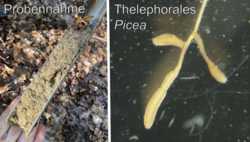Kurzfassung
In response to anthropogenic inputs of air pollutants (NOx und SO2) until the 1980s, compensation measures were carried out across Europe. Liming releases organic carbon and nitrogen and increases base cations, and soil fertility is increased. This has consequences for the entire forest ecosystem, including microorganisms, plants and animals. In particular, ectomycorrhizal fungi (ECM) are essential symbionts of woody plants, they improve water and nutrient supply of their hosts and could...In response to anthropogenic inputs of air pollutants (NOx und SO2) until the 1980s, compensation measures were carried out across Europe. Liming releases organic carbon and nitrogen and increases base cations, and soil fertility is increased. This has consequences for the entire forest ecosystem, including microorganisms, plants and animals. In particular, ectomycorrhizal fungi (ECM) are essential symbionts of woody plants, they improve water and nutrient supply of their hosts and could protect against pathogens.
In cooperation with the Research Institute for Forest Ecology and Forestry of the State of Rhineland-Palatinate (FAWF), soil parameters, biomass and diversity of soil fungi and fruiting bodies are to be evaluated at 16 locations on long-term liming areas across Rhineland-Palatinate.» weiterlesen» einklappen

